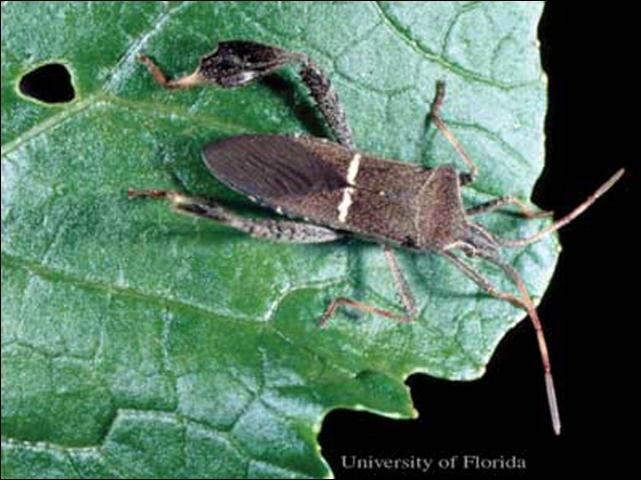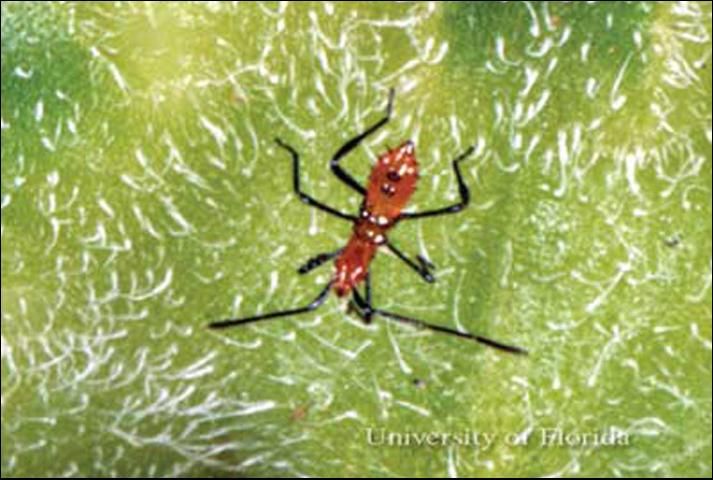The Featured Creatures collection provides in-depth profiles of insects, nematodes, arachnids and other organisms relevant to Florida. These profiles are intended for the use of interested laypersons with some knowledge of biology as well as academic audiences.
Introduction
The leaffooted bug, Leptoglossus phyllopus (Linnaeus) (Figure 1), is a widespread and conspicuous minor pest of many kinds of crops, including fruits, vegetables, grains, nuts, and ornamentals. It has been reported as a major pest in citrus groves, where its feeding on ripening fruit causes premature color break and fruit drop. Serious infestations do not occur often, but a large proportion of the crop may be lost when they do.

Credit: John Capinera, University of Florida
Distribution
A revision of Leptoglossus by Allen (1969) lists Leptoglossus phyllopus as a very common insect in the southern United States. It is reported as far north as Long Island, New York, and ranges south to Florida, west to Iowa and Kansas, and southwest through Texas to California, including Lower California, and south again into Mexico, Guatemala, and Costa Rica. Allen (1969) mentioned literature records of it for Panama and Brazil. The USDA Cooperative Economic Insect Report has isolated entries of the leaffooted bug in Colorado and Utah.
Identification
Nine species of Leptoglossus have been recorded from Florida. Leptoglossus phyllopus can almost always be separated from the other species by the character of the elytral crossbar (on the corium). Leptoglossus phyllopus is the only pertinent species having the bar straight and in its entirety. The bars of the other species usually vary from zigzag bands to faint dots or no marks at all. One possible exception is the rarely collected Leptoglossus ashmeadi Heidemann, a species that breeds in mistletoe. This species has an unusually broad, orange crossbar, compared to the narrower white or pale-yellow bar in Leptoglossus phyllopus. Furthermore, Leptoglossus ashmeadi has prominent orange-yellow margins on the pronotum not found in Leptoglossus phyllopus. Leptoglossus zonatus is most easily distinguished from other Florida Leptoglossus spp. by the presence of two large, whitish-yellow spots on the anterior portion of the pronotum.
Several species of Leptoglossus and other coreids have foliaceous hind tibiae, which give rise to the common name "leaffooted bug," but only Leptoglossus phyllopus has this as an accepted common name. Adults of Leptoglossus phyllopus generally are chestnut brown, reveal various amounts of orange on the dorsal abdomen when the wings are raised, and vary from 1.6 to 1.9 cm long (5/8 to 3/4 inch). Nymphs (Figure 2) have much the same shape as adults, but do not acquire the flattened leaf-like hind tibial expansions until well along toward becoming adults. Eggs are golden brown and are laid in a single row or chain along a stem or leaf midrib. They are somewhat cylindrical, flattened on the undersides and at the ends, and are closely laid end to end, forming a stiff cylindrical rod in which each egg appears as a joint or cell. For additional aid on the identification of Leptoglossus consult Blatchley (1926), Hussey (1953), or Allen (1969).

Credit: Lyle J. Buss, University of Florida
Economic Importance
Normally, the principal host plants are thistles, Cirsium spp. Hubbard (1885) wrote that young leaffooted bugs were found rarely in Florida except on thistle or similar succulent plants, but that the adults flew very great distances and entered orange groves at the time of blooming to suck the opening buds or tender shoots. Later, the adults were found attacking ripening fruit, causing it to drop. Puncturing the fruit allows secondary pathogens to enter and cause rotting. Most of the problem on citrus (Figure 3) involves early and mid-season oranges, tangerines, and satsumas, with injury usually occurring between early September and late November, according to Griffiths and Thompson (1957). They add that the bugs may start at one margin of a grove and move across it, feeding on and causing the fruit to drop. Watson and Berger (1937) stress that the leaffooted bug has a habit of aggregating into large colonies, and that one tree may be swarming with them while a neighboring tree is entirely free. There are numerous records of Leptoglossus phyllopus caught in Steiner traps placed in citrus trees. Leptoglossus phyllopus is a multivoltine species. Adults have been found all months of the year in the Deep South, but populations attain peak numbers during the warmer months.
Pecan is one of the other crops attacked. Leptoglossus phyllopus is one of the bugs that causes black pit and kernel spot of pecan. Ebeling (1959) describes black pit as a blackening of the inside of the pecan. Nuts with black pit fall prematurely. Punctures made by the bugs after the nuts have passed the "water stage" do not cause black pit, but instead cause the condition called "kernel spot," which consists of dark brown or black spots on the kernels.
Other crops sometimes heavily infested include apple, bean, bell pepper, blueberry, blackberry, cowpea, cucurbits, eggplant, grain sorghum, lychee, loquat, oat, okra, peach, pear, persimmon, plum, pomegranate, potato, tomato, sunflower, and, to a lesser extent, rye, wheat, barley, and soybean.
Some of the ornamentals attacked include beargrass, crape myrtle, Gerbera daisy, gladiolus, hibiscus, ixora, ligustrum, and rose. Wild hosts include elderberry, goldenrod, jimsonweed, and thistle.
In 2008, leaffooted bug was identified as a potential vector of sorghum fungal pathogens (Prom and Perumal).

Credit: Lyle J. Buss, University of Florida
Management
The leaffooted bug is controlled by application of insecticides, cultural practices, and by hand picking.
In Florida citrus groves, the last spray of the season that normally contains an insecticide is the scalicide applied in June or July. However, this does not prevent a buildup of leaffooted bugs later in summer on grove cover crops. Several authorities have mentioned the importance of cover crop management and elimination of nearby miscellaneous hosts. Griffiths and Thompson (1957) and Ziegler and Wolfe (1961) mentioned that if leaffooted bugs are expected to be a problem, the cover crops should be chopped and disked in September before green citrus fruits become attractive to the adults or while the bugs are still in an immature, wingless stage. Fields containing watermelons, citrons, hairy indigo, crotalaria, velvet beans, thistles, etc., should be examined, and if infestations of bugs are found in September in fields adjacent to early ripening citrus varieties, these fields should be thoroughly cultivated. Caution must be exercised to make sure citrus is not in an attractive condition to the bugs; otherwise, if winged forms are present, they may concentrate on the citrus after other nearby hosts are destroyed. The citron bug, Leptoglossus gonagra (F.), is another coreid known to damage citrus after building up on melon-like citrons.
For more information, refer to the Florida Citrus Pest Management Guide (https://edis.ifas.ufl.edu/publication/CG005).
Selected References
Allen RC. 1969. A revision of the genus Leptoglossus Guerin (Hemiptera: Coreidae). Entomologica Americana 45: 35–140.
Blatchley WS. 1926. Heteroptera or True Bugs of Eastern North America, with Especial Reference to the Faunas of Indiana and Florida. Nature Publishing Company, Indianapolis, USA. 1116 pp.
Ebeling W. 1959. Subtropical Fruit Pests. University of California, Division of Agricultural Science, Los Angeles, USA. 436 pp.
Griffiths JT, Thompson WL. 1957. Insects and mites found on Florida citrus. University of Florida Agricultural Experiment Station, Gainesville, FL. Bulletin 591: 1–86.
Hubbard HG. 1885. Insects Affecting the Orange. U.S. Department of Agriculture, Division of Entomology, Washington, D.C., USA. 227 pp.
Hussey RF. 1953. Concerning some North American Coreidae (Hemiptera). Bulletin of the Brooklyn Entomological Society 48: 29–34.
Prom LK, Perumal R. 2008. Leaf-footed bug, Leptoglossus phyllopus (Hemiptera: Coreidae), as a potential vector of sorghum fungal pathogens. Southwestern Entomologist 33: 61–164.
Watson JR, Berger EW. 1937. Citrus insects and their control. University of Florida Agricultural Extension Service Bulletin 88: 1-135.
Ziegler LW, Wolfe HS. 1961. Citrus Growing in Florida. University of Florida Press. Gainesville, USA. 248 pp.